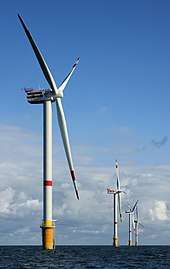Sustainable refurbishment
Sustainable refurbishment describes working on existing buildings to improve their environmental performance using sustainable methods and materials.
Sustainable refurbishment is the equivalent of sustainable development which relates to new developments of cities, buildings or industries etc. Sustainable refurbishment includes insulation and related measures to reduce the energy consumption of buildings, installation of renewable energy sources such as solar water heating and photovoltaics, measures to reduce water consumption, and changes to reduce overheating, improve ventilation and improve internal comfort. The process of sustainable refurbishment includes minimizing the waste of existing components, recycling and using environmentally friendly materials, and minimizing energy use, noise and waste during the refurbishment.
The importance of sustainable refurbishment is that the majority of buildings in use are not new and thus were constructed when energy standards were low or non-existent, and are otherwise incompatible with current standards or the expectations of users. Much of the existing building stock is likely to be in use for many years to come since demolition and replacement is often unacceptable owing to cost, social disruption or because the building is of architectural and/or historical interest. The solution is to refurbish or renovate such buildings to make them appropriate for current and future use and to satisfy current requirements and standards of energy use and comfort.
Sustainable refurbishment is not a new concept but is gaining recognition and importance owing to current concerns about high energy use leading to climate change, overheating in buildings, the need for healthy internal environments, waste and environmental damage associated with materials production. Many governments are beginning to realize the importance of sustainably renovating their existing building stock, rather than just raising standards for new buildings and developments, and are producing guidance and grants and other support and stimulation activities. Think-tanks, lobby groups and voluntary organizations continue to publicize and promote the need for and practice of sustainable refurbishment. Examples and demonstration projects abound in many countries.
The techniques of sustainable refurbishment have been developing over many years and though the principles are very similar to those used on new buildings, the practice and details appropriate for the wide range of situations found in old buildings has required development of specific solutions and guidance to optimize the process and avoid subsequent problems. Detailed technical guidance is widely available from government-sponsored sources.
Example demonstration projects
Sources of technical guidance
- http://www.energysavingtrust.org.uk
- http://www.ademe.fr
- http://www.nps.gov/tps/standards/rehabilitation/guidelines/index.htm
References
Several books on the subject have been published aimed at different audiences, for example:
- for architects and other professionals:
- The Handbook for Sustainable Refurbishment – Housing
- Handbook for Sustainable Refurbishment - Non-domestic Buildings
- for the DIY market: Sustainable Home Refurbishment
all available from http://www.routledge.com.
